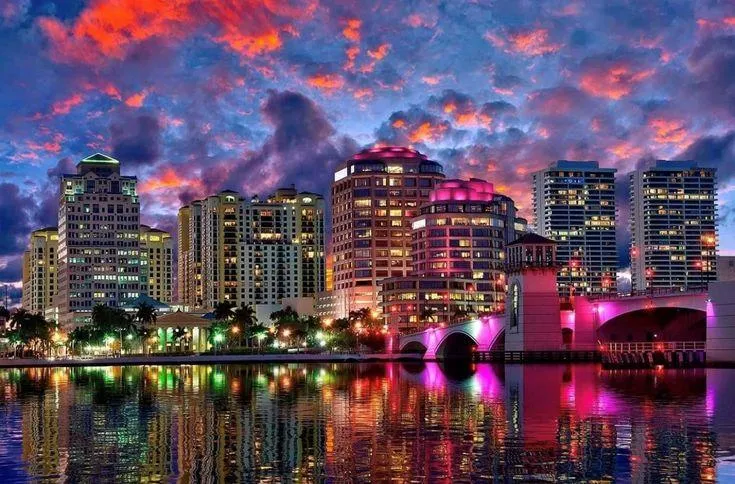Expert Carpet Cleaner in West Palm Beach Gets Carpets Spotless!
Top Rated Carpet Cleaning Service in West Palm Beach for Homes and Offices
Most Trusted Carpet Cleaner for Homes & Offices in West Palm Beach
For residents and businesses in West Palm Beach, Word of Mouth offers premier carpet cleaning services designed to restore and maintain the beauty of your carpets. Our expert team utilizes advanced eco-friendly cleaning techniques to remove deep-seated dirt, stains, and allergens, ensuring a fresh and healthy living space. With our customer satisfaction guarantee, we take pride in delivering outstanding results every time.
Fresh, Clean, and Like New:
West Palm Beach's Top-Quality Carpet Cleaning Service
Our Carpet Cleaning Services in West Palm Beach
At Word of Mouth, we cater to the unique cleaning needs of West Palm Beach with services that include:
Deep Steam Cleaning: High-temperature steam effectively lifts dirt, bacteria, and allergens from your carpet fibers, promoting a healthier home.
Advanced Stain Removal: From tough pet stains to wine spills, we use specialized techniques to eliminate even the most stubborn stains.
Eco-Friendly Carpet Cleaning: Our biodegradable and non-toxic cleaning solutions provide a safe and effective cleaning experience.
Odor Removal Solutions: Our deodorizing treatments neutralize unpleasant odors, leaving your carpets smelling fresh.
Carpet Protection Treatment: We apply protective coatings that help resist future stains and extend the lifespan of your carpets.
Why Choose Word of Mouth for Carpet Cleaning?
Residents of West Palm Beach trust Word of Mouth for their carpet cleaning needs because of the many benefits we offer:
Improved Indoor Air Quality: Our deep cleaning methods remove dust, allergens, and bacteria, creating a healthier environment.
Revitalized Carpet Appearance: Regular cleaning keeps your carpets looking vibrant and new.
Extended Carpet Lifespan: Our services prevent dirt buildup that can cause premature wear and tear.
Environmentally Friendly Cleaning: We use green cleaning solutions that are safe for kids, pets, and the environment.
100% Customer Satisfaction Guarantee: We stand behind our work and ensure you’re completely satisfied with our service.
Trusted Carpet Cleaners in West Palm Beach
Word of Mouth has earned a reputation as a reliable and professional carpet cleaner in West Palm Beach. Our commitment to quality, eco-conscious methods, and exceptional customer service make us the top choice for homeowners and businesses alike.If you're in need of expert carpet cleaning in West Palm Beach, reach out to Word of Mouth today! Experience the difference of a cleaner, healthier home.

West Palm Beach Carpet Cleaning Services
Carpet Cleaning
Tile Grout Cleaning
Furniture Cleaning
Area Rug Cleaning
Mattress Cleaning
Carpet Repair Company West Palm Beach
Carpet Repair
Carpet Stretching
Carpet Patching
Pet Damaged Carpet
Carpet Burn Repair

We Serve the Entire Tri-County Area in South Florida
From Miami to Palm Beach we offer all our services to our south Florida customers
Schedule a cleaning with
your Palm Beach expert today.
"Word of Mouth did a wonderful job! I got their name from my cleaning service. I had previously always used a very large well-known national service. Word of Mouth trumped them with price and quality."
Sandra A.

Historic neighborhoods and communities
Comeau Building, Clematis Street
Bel Air Historic District: Developed from 1925 to 1935 as a neighborhood for tradesmen and real estate salesmen who helped develop Palm Beach County, some of Belair was originally a pineapple plantation owned by Richard Hone. Hones's frame vernacular house, built around 1895, still stands at 211 Plymouth Road. After Hone was murdered in 1902, his property was sold to George Currie, who created Currie Development Co. But before it was developed, the land was sold to William Ohlhaber, who raised coconut palms and ferns. Eventually, Ohlhaber platted the subdivision and sold off lots. The first house built in the subdivision was Ohlhaber's mission-style home at 205 Pilgrim. Ohlhaber's grandson said Ohlhaber bought the tract to provide dockage for his 90-foot (27 m) yacht, but the yacht ran aground in the Gulf of Mexico and never reached Lake Worth. In 1947 Hone's house was bought by Max Brombacher, Henry Flagler's chief engineer, and it remains in the Brombacher family today. Belair became West Palm Beach's fourth historic district in August 1993.
Central Park: Central Park is a collective name for several subdivisions north of Southern Boulevard. It originally was part of the Estates of South Palm Beach (which went from Wenonah Place to Pilgrim Road east of Dixie Highway). Like other West Palm Beach neighborhoods, the Estates of South Palm Beach boomed after Henry Flagler's descent on Palm Beach. In 1884, James W. Copp, a bachelor in the boating business, borrowed $367.20 from Valentine Jones to buy the land. The ownership of what is now known as Central Park changed hands many times before being developed. Around 1919, the tropical wilderness was transformed into an exclusive neighborhood with curbed roads, sidewalks and a pier (at the foot of what is now Southern Boulevard). The neighborhood became part of West Palm Beach in 1926, and was named a city historic district in December 1993. In 1999 the neighborhood was listed in the National Register of Historic Places.
El Cid: Noted for its Mediterranean revival and mission-style homes, El Cid developed in the height of Florida's real estate boom. In the late 19th century, most of the land north of Sunset Road was pineapple fields, but the crop dwindled in the early 20th century. Pittsburgh socialite Jay Phipps subdivided the old pineapple fields in the 1920s. He named it El Cid, after the celebrated Spanish hero, Rodrigo Díaz de Vivar, who conquered Valencia in 1094. He was called "Cid", meaning "lord". El Cid became a city historic district in June 1993. In 1995 the neighborhood was listed in the National Register of Historic Places.
Flamingo Park: Originally a pineapple plantation, Flamingo Park was established by local contractors and developers, who saw the potential in this area—one of the highest coastal ridge sections from downtown West Palm Beach to Miami. Some ridge houses even had ocean views from upper floors. Houses cost about $10,000 to $18,000 in the boom era, and many buyers were owners of shops and businesses on fashionable Dixie Highway nearby. Recently, residents rallied to have stop signs installed throughout the neighborhood and have banded together to ward off commercial and industrial zoning. Property values are rising as residents renovate and restore Spanish-style houses. Most of the homes in the neighborhood, developed from 1921 to 1930, are mission style, but nearly every style is represented. There are many Mediterranean revival-style houses along the high ridge line. Only two buildings in the historic district are known to have been designed by architects: 701 Flamingo Drive designed by Harvey and Clarke, and the Armory Arts Center designed by William Manly King. The neighborhood became a West Palm Beach historic district in January 1993 and was listed in the National Register
Grandview Heights: One of the city's oldest neighborhoods still intact, Grandview Heights was built as an extension of Palm Beach Heights from around 1910 to 1925. Almost all of Palm Beach Heights and half of Grandview Heights was demolished in 1989 to make way for the proposed Downtown/Uptown project, which became CityPlace. Grandview Heights originally attracted construction workers who helped build the luxury hotels, ministers and store owners. The neighborhood has one of the city's best collection of early craftsman-style bungalows, as well as some modest, Mediterranean revival-style homes. The neighborhood became a West Palm Beach historic district in 1995 and was listed in the National Register of Historic Places in 1999.
Mango Promenade: Mango Promenade became a West Palm Beach historic district in 1995 and was listed in the National Register of Historic Places in 1999. Lies just south of Palm Beach Atlantic University.
Northboro Park: An expansion of Old Northwood, Northboro Park was mostly custom houses for upper-middle-class professionals. Most of the houses are Mediterranean revival, mission and frame vernacular. Developed from 1923 to 1940, the neighborhood became the city's second historic district (November 1992) and the historic designation may soon expand north to 45th Street. The oldest building in the neighborhood is Northboro Elementary School at 36th Street and Spruce, built in 1925 by DaCamara and Chace. The demolition of Northboro Elementary School began in late 2009. The first home in Northboro Park is 418 36th St., built in 1923.
Northwest: West Palm Beach's first historic district to be included on the National Register of Historic Places (February 1992), the Northwest neighborhood was first settled in 1894, when the black community was moved from the Styx in Palm Beach to West Palm Beach. It also served as the city's segregated black community from 1929 to 1960 (along with Pleasant City). Northwest remains a predominantly black community but according to the city planning department, most middle- and upper-class blacks moved to other neighborhoods after desegregation. Tamarind and Rosemary Avenues were the commercial centers for blacks by 1915, but most commercial buildings have been demolished or remodeled so the architecture is no longer significant. There are still good examples of late 19th- and early 20th-century American bungalow/craftsman-style homes in this neighborhood, which also has mission, shotgun, Bahamian vernacular and American Foursquare styles. The Alice Frederick Mickens house, at 801 Fourth St., is listed on the National Register of Historic Places. Mickens was a philanthropist and humanitarian who promoted education for black youth. Another notable house is the Gwen Cherry house at 625 Division Ave. Cherry, Florida's first Black woman legislator and a resident of Miami, inherited the house from relative Mollie Holt, who built the house in 1926. Now it is the Palm Beach County Black Historical Society. The Northwest neighborhood was listed in the National Register of Historic Places in 1992. The next year the neighborhood became a West Palm Beach historic district in 1993.
Old Northwood Historic District: Old Northwood was developed from 1920 to 1927—the height of the city's real estate boom. The Pinewood Development Co., platted and developed the area. Old Northwood became a neighborhood of what was considered extravagant Mediterranean revival, mission and frame vernacular houses, at $30,000 to $36,000. The buyers were professionals, entrepreneurs and tradesmen. Among them was David F. Dunkle, who was mayor of West Palm Beach. There are houses here designed by notable architects John Volk (best known for his Palm Beach houses), William Manly King (who designed Palm Beach High School and the Armory Arts Center) and Henry Steven Harvey (whose Seaboard Railroad Passenger Station on Tamarind Avenue is listed in the National Register of Historic Places). The neighborhood became a West Palm Beach historic district in 1991 and listed in the National Register of Historic Places in June 1994.
Northwood Hills Historic District: On August 4, 2003, the City Commission designated the Northwood Hills neighborhood as the 13th Historic District in the City of West Palm Beach. Northwood Hills comprises the area from 29th Street on the South to 39th Court on the North. The east side of Windsor is the Western boundary, and Greenwood Avenue is the Eastern boundary.[43] The Neighborhood Association has worked several years to achieve the distinction of historic designation. This is the first district to be designated since 1996. Northwood Hills has a number of Mission Revival houses, a significant collection of Post-World War II architecture, a unique street layout, and one of the highest elevations in the city. The Northwood Hills neighborhood has also elected to allow the establishment of Bed and Breakfast establishments within the neighborhood.
Prospect Park: Promoted as a high-end neighborhood patterned after the prominent Prospect Park district in Brooklyn, this area consisted of mostly smaller estates for prominent businesspeople and northern investors. The neighborhood has a high concentration of Mediterranean revival and Mission revival houses. It was developed from 1920 to 1935 and became a city historic district in November 1993.
West Northwood Historic District: Cashing in on the real estate boom, developers of West Northwood built speculative and custom houses for upper-middle-class professionals from 1925 to '27. Dominant architectural styles are Mediterranean revival and mission. Although the area was declining, that has reversed in recent years, as more investors buy and restore the houses. West Northwood became a city historic district in August 1993.

WOM Carpet & Tile/Grout Cleaning in South Florida knows the importance of keeping your carpets clean. We specialize in removing tough stains and heavy duty traffic dirt. Our Carpet Cleaners near me are honest and reliable, and have been trained to the highest industry standard in the art of carpet cleaning and care by the IICRC. We use top of the line high powered truck mounted carpet cleaning machine.
Call or Text
TEXT us Anytime
Call Today Clean Today




